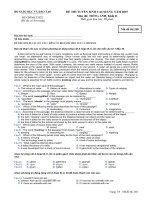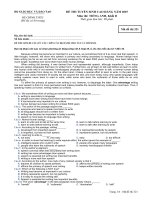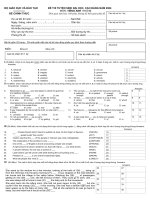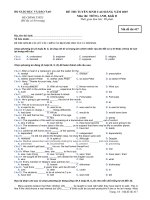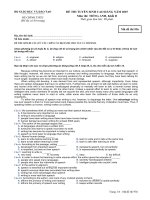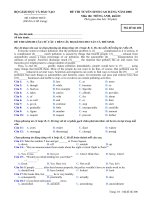tài liệu dạy trực tuyến môn tiếng anh khối 6
Bạn đang xem bản rút gọn của tài liệu. Xem và tải ngay bản đầy đủ của tài liệu tại đây (212.95 KB, 10 trang )
<span class='text_page_counter'>(1)</span><div class='page_container' data-page=1></div>
<span class='text_page_counter'>(2)</span><div class='page_container' data-page=2>
<b>ONLINE TEST 1</b>
<b>PART 1. PHONETICS </b>
<b>I. Find the word which has a different sound in the underlined part. </b>
1. A. cold B. volleyballC. telephone D. open
2. A. meat B. reading C. bread D. seat
3. A. writes <i> B. makes</i> C. takes D. drives
4. A. favourite B. name C. happy D. danger
5. A. end B. help C. set D. before
/əʊ / /ɔ/ /əʊ / /əʊ /
/i/ /i/ /e/ /i/
/s/ / s / <sub>/s /</sub> / z /
/ ei / <sub>/ ei /</sub> <sub>/ æ /</sub> <sub>/ei/</sub>
</div>
<span class='text_page_counter'>(3)</span><div class='page_container' data-page=3>
<b>PART A. PHONETICS </b>
<b>II. Find the word which has different stress from the others.</b>
<b>1. A. waterfall</b> B. historic C. fantastic D. pagoda
2. A. hospital B. bakery C. stadium D. hotel
3. A. brother B. doctor C. sister D. sixteen
4. A. armchair B. hello C. police D. eraser
5. A. living B. fifteen C. mother D. people
</div>
<span class='text_page_counter'>(4)</span><div class='page_container' data-page=4>
<b>PART 2. USE OF ENGLISH</b>
<b>I. Choose the correct answers. </b>
1. My grandfather ……….fishing in his free time.
A. does B. do C. goes D. go
2. ... sports do you play?
A. what B. which C. why D. how
3. Where are you, Hoa? I’m downstairs. I ……….to music.
A. to listenB. listen C. listens D. am listening
4. This Saturday we ………. to the Art Museum.
A. go B. is going C. are going D. went
5. I like ... programmes. They make me laugh
A. horror B. comedy C. national D. local
6. Which shirt is ……….., this one or that one?
</div>
<span class='text_page_counter'>(5)</span><div class='page_container' data-page=5>
<b>PART B. VOCABULARY & GRAMMAR </b>
<b>I. Choose the correct answers. </b>
7. Who ... you ... badminton with yesterday?
A. do - play B. did - play C. are – play D. did - played
8. ...is a man on a television or radio programme who gives a
weather forecast
A. MC B. weatherman C. newsreader D. viewer
9. We use the ... to change the channel from a distance
A. remote control B. volume button C. TV D. laptop
10. We …………....keep quiet in the library so that everyone can enjoy
reading books.
A. shouldn't B. should C. can ’t D. can
11. A: ... do you play football? B: twice a week
A. what B. why C. how often D. how
</div>
<span class='text_page_counter'>(6)</span><div class='page_container' data-page=6>
<b>PART B. VOCABULARY & GRAMMAR </b>
<b>I. Choose the correct answers. </b>
12. Both educational channels ... TV cartoon series always teach
children life lessons.
A. so B. and C. but D. or
13. ... The Little Big Shots is a famous American television
series, I have never watched it.
A. Because B. Although C. So D. But
14. I ... at the ... last Sunday, but I did not see you there
A. was - gym B. were - football
C. am - gym D. did - gym
15. How many goals did you ... in total?
</div>
<span class='text_page_counter'>(7)</span><div class='page_container' data-page=7>
<b>PART C. READING </b>
American students usually attend an elementary school in their
neighbourhood. The school year usually runs from early September
to mid-June. School days last from Monday to Friday. Classes start at
9 a.m and finish at 3 p.m. Students have a two-week vacation, a
one-week spring vacation and two-month summer vacation. Elementary
school programs consist of language arts, history, geography, maths,
science, music, art, physical education and health. In big cities, many
students live close enough to walk to school and come home for
lunch. However, most elementary schools have a canteen. Students
<b>can go there at break-time. They can buy some snacks and drinks </b>
there.
1. The school year usually begins in late September.
2. Students often have lessons five days a week.
3. In the summer, students have a two-month vacation.
4. Students can buy some snacks and drinks at a food-stall.
5. Many students living near the school have lunch at the canteen.
<b>I. Read the passage, then decide whether the sentences are True or False.</b>
</div>
<span class='text_page_counter'>(8)</span><div class='page_container' data-page=8>
<b>PRACTICE TEST 4</b>
American students usually attend an elementary school in their
neighbourhood. The school year usually runs from early September
to mid-June. School days last from Monday to Friday. Classes start at
9 a.m and finish at 3 p.m. Students have a two-week vacation, a
one-week spring vacation and two-month summer vacation. Elementary
school programs consist of language arts, history, geography, maths,
science, music, art, physical education and health. In big cities, many
students live close enough to walk to school and come home for
lunch. However, most elementary schools have a canteen. Students
<b>can go there at break-time. They can buy some snacks and drinks </b>
there.
1. The school year usually begins in late September.
2. Students often have lessons five days a week.
3. In the summer, students have a two-month vacation.
4. Students can buy some snacks and drinks at a food-stall.
5. Many students living near the school have lunch at the canteen.
<b>F</b>
<b>T</b>
<b>T</b>
<b>F</b>
</div>
<span class='text_page_counter'>(9)</span><div class='page_container' data-page=9>
<b>PART D. WRITING </b>
<b>V. Rearrange the words to make meaningful sentences</b>
1. camping / often / do / how / you / go?
2. should/ do / you / your homework / to / go / school / before / you
<b>ONLINE TEST 1</b>
<b>How often do you go camping?</b>
</div>
<span class='text_page_counter'>(10)</span><div class='page_container' data-page=10>
1. Hanoi is large, Bangkok is larger and Tokyo is the largest.
<i><b>→ Tokyo </b></i> the three cities.
2. The garden is behind Lan’s house.
<i><b>→ Lan’s house</b></i>
3. Please tell me something about your school.
<i><b>→ Can </b></i>
<b>PART D. WRITING </b>
<b>VI. Rewrite the sentences so that its meaning stays the same.</b>
<b>ONLINE TEST 1</b>
<b>is the largest of </b>
<b>is in front of the garden. </b>
</div>
<!--links-->
